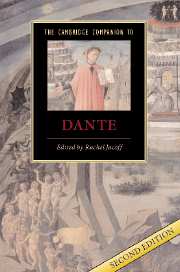Book contents
- Frontmatter
- 1 Life of Dante
- 2 Dante and the lyric past
- 3 Approaching the Vita nuova
- 4 From auctor to author: Dante before the Commedia
- 5 Introduction to Inferno
- 6 Introduction to Purgatorio
- 7 Introduction to Paradiso
- 8 Dante and the Bible
- 9 Dante and the classical poets
- 10 Allegory and autobiography
- 11 A poetics of chaos and harmony
- 12 The theology of the Comedy
- 13 The poetry and poetics of the creation
- 14 Dante and Florence
- 15 Dante and the empire
- 16 Dante and his commentators
- 17 Dante in English
- Further reading
- Index
- Series List
5 - Introduction to Inferno
Published online by Cambridge University Press: 28 May 2007
- Frontmatter
- 1 Life of Dante
- 2 Dante and the lyric past
- 3 Approaching the Vita nuova
- 4 From auctor to author: Dante before the Commedia
- 5 Introduction to Inferno
- 6 Introduction to Purgatorio
- 7 Introduction to Paradiso
- 8 Dante and the Bible
- 9 Dante and the classical poets
- 10 Allegory and autobiography
- 11 A poetics of chaos and harmony
- 12 The theology of the Comedy
- 13 The poetry and poetics of the creation
- 14 Dante and Florence
- 15 Dante and the empire
- 16 Dante and his commentators
- 17 Dante in English
- Further reading
- Index
- Series List
Summary
A dark and menacing forest dominates the Comedy's opening scene:
In the middle of the journey of our life, I came to myself in a dark wood, for the straight way was lost.
The character who says “I” does not tell us how he got there. He himself does not seem to know; indeed he only suddenly becomes aware of the alien, nightmarish reality that surrounds him. But who is this character? He is both the protagonist of the story and its narrator, a character who has survived his adventure and is now in the process of writing it down: a character-poet. Unlike Homer and Virgil who always say “he,” never “I,” and unlike Ulysses and Aeneas who went to Hell but did not write the stories of their own journeys, the protagonist and the narrator of the Comedy are one and the same.
They are one but they undertake separate journeys within the poem: the journey of the character from the dark forest to the Empyrean heaven, where God dwells with all the blessed; and the journey of the narrator through the one-hundred cantos of the poem, from canto 1 of the Inferno to canto 33 of the Paradiso. The first journey lasts one week; the second, to the best of our knowledge, took at least a dozen years (circa 1307-20). In fact, we are given to understand along the way that, whereas the experience of the journey was willed and facilitated by Divine Providence, the poem, the work of the narrator, is in a sense a far more difficult undertaking, a task that costs him “hunger, cold and vigils” (Purgatorio 29, 37-38): the poet's daunting task is to find words adequate to his experience, “so that the word may not be different from the fact” (Inf. 32, 12).
- Type
- Chapter
- Information
- The Cambridge Companion to Dante , pp. 67 - 90Publisher: Cambridge University PressPrint publication year: 2007
- 2
- Cited by

